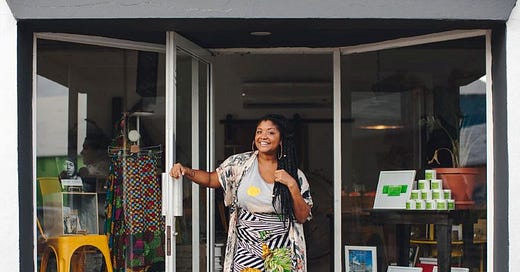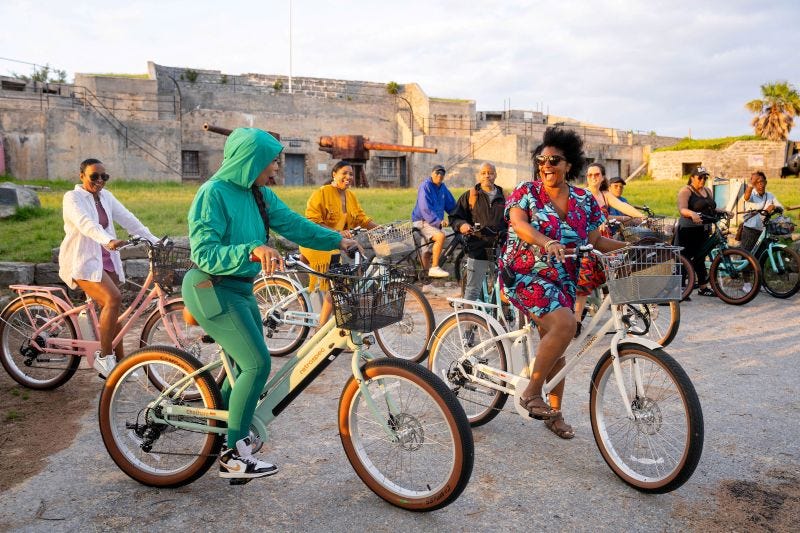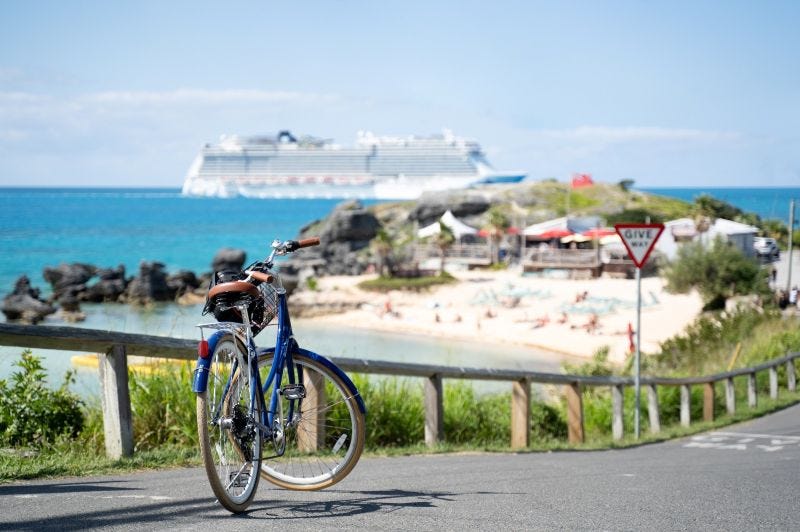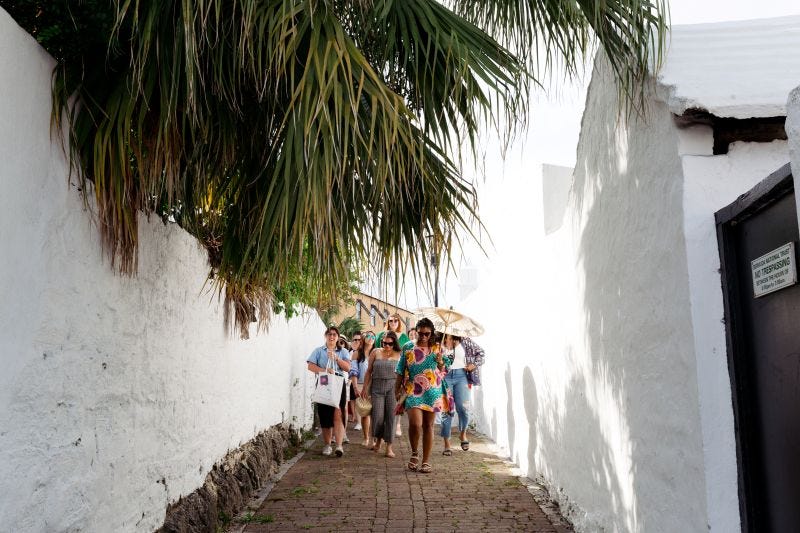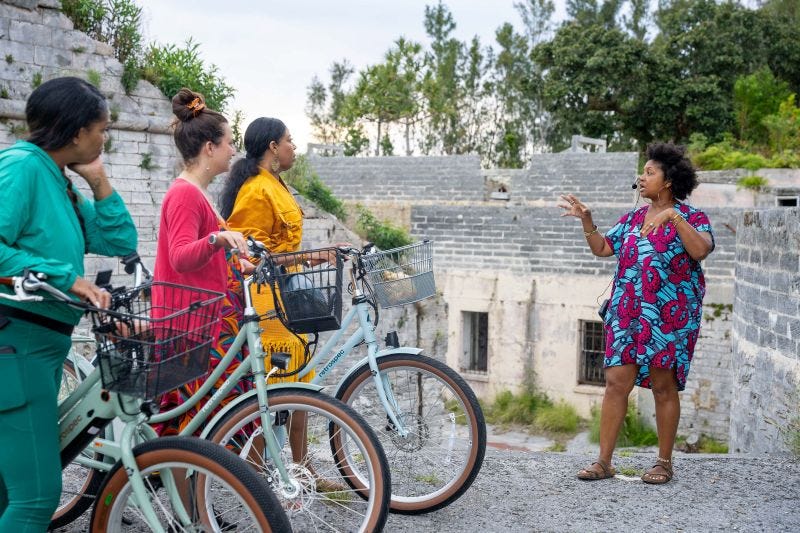I actually feel a spiritual connection to the stories that I'm telling
On the road with Kristin White, bookseller and guide in St. George's, Bermuda
In my work travel writing, I meet a lot of creative people who work in the tourism industry—folks who think about community building and defining what place means to them in order to share that vision with others. Last year when I visited Bermuda for a story, I met Kristin White, and I’ve not been able to stop thinking about her history tour of St. George’s ever since.
Kristin does a bit of everything. She’s the bookseller and business owner behind Long Story Short. She’s a writer and community activist. She’s been featured in Conde Nast Traveler, Afar, Essence, and The Today Show (who called her a “local hero”). When I went on her tour, she’d just filmed a pilot.
I was so compelled by her storytelling, and we caught up about her tours, community engagement, the power of history, and how she sees sharing St. George’s stories fits within her life today.
How long have you been giving tours in St. George’s? How did you get your start?
This is my 10-year anniversary of giving tours. I started in 2015, and at the time I was working in St George's for the St George's Foundation. My background is in nonprofit management, so I had been the executive director of a youth charity. In working with young adults in Bermuda, I was working on the lack of entry level jobs and how that was impacting young people who were trying to turn their lives around. Long story short, I decided I wanted to leave youth development and focus on community development, so I left the charity I was working at and came to work at the St George's Foundation as a development director, thinking that I wanted to work on building up the tourism industry in St George's as a direct vehicle for job creation.
As I was getting involved with tourism in St George's, there were a lot of limiting beliefs about St George's. Between 2008 and 2012, we lost about 80% of the businesses in St George's. It was a cruise ship town, and cruise ships stopped coming. They got too big to actually fit into the harbor, and so the businesses closed down. Everybody in St George's was just like, “Oh, tourists don't care about us. Nobody cares about St George's. Nobody wants to come down here to the museums. Nobody wants to do tours.” And I thought, “If we put on a really cool tour, people would come to do it.”
In the summer of 2015 I created a nighttime ghost tour called Haunted History, and it was a theatrical walking tour, a performance where my storyteller would have on his cape and top hat and his lantern, and as they walked around, telling true stories about the town, the ghost of the person that he was talking about would come out to interact with the group. We were paying actors, young people, makeup artists—we created these jobs around this tour, and it was very popular. It started one night a week, we moved to two nights a week. It was always sold out.
After that, I became the tourism manager for St George's, and as part of my job, I would often be showing around a journalist or an influencer. At the time, I rode a bicycle that was called Shoshana. She was a really popular bicycle. She won a Best of Bermuda award for Best Bermuda character. I wrote a column called, “My View from Behind Bars,” talking about what I was seeing on my handlebars, and a bicycle rental company in town started renting bicycles that looked exactly like mine. With these bicycles in town, I could do bicycle tours. Shoshana was a very big part of the beginning of me having a tour company, because people were very adamant from the media standpoint that it wasn't just me. They were like, “We need you and your bicycle.” I started doing tours for just journalists, then other people started seeing me doing those and would ask if I could do a tour for their groups that were coming into Bermuda, and it spiraled from there.
I love St George's. I love talking about St George's, and I feel that if we can get people excited about St George's and the stories here, it would be an incredible vehicle for economic development and job creation for the island.
You described the period of contraction. Has that started to shift?
Yeah, for sure. Once COVID happened, we were still struggling to get back the pre-COVID infrastructure of regular ferry lifts, but last year and this year, we've had regular public ferries to St George's for the first time since 2019.
I think a lot of people who think about St George's are reflecting to a time that doesn't exist, where they'll still think, “Oh, there's nothing going on there.” We have our challenges as a town—we do—but it's so vibrant and amazing here. There’s a lot of cool things happening. Even my son, who's in his late twenties and has lived in Saint George his whole life, says, “St George's—this is our time now.”
What do you think distinguishes your community so much? What makes it so special?
I'm not from Saint George's. I'm actually from the more central parishes, and I've been living in Saint George's now for just over 20 years. I moved here in 2003. I raised my son here. This is where I got married. I moved down here with my then-boyfriend, now my husband. I'd never been part of a community like this. My son got really involved with the Cricket Club, and that's how I met everybody in St George's. Then I started my business, so I became friendly with other entrepreneurs.
I just love being part of a vibrant community. Even with the challenges that the town has faced, the community, I feel, doesn't waver. We always have a group of dedicated entrepreneurs. We always have a group of dedicated cultural and heritage experts and enthusiasts. We always have a group of residents that are volunteering, that are repping their St George's cricket club team. Community has always been at the heart of what I've seen since I've been down here, and I just love it. I'm so emotional about it, because moving to St. George’s truly changed the trajectory of my life.
This town is a World Heritage Site. I's been a part of massive moments in history over the last 400 years. Because of that, I feel this incredible sense of place. I'm touching cedar beams and limestone walls, and thinking, “Did my ancestor carve these? Who was here? Who walked in these places?” I feel so connected always, always, always to the history of the place, to the point that I actually feel a spiritual connection to the stories that I'm telling. All of that, to me, is so important, and on top of it, it's this vibrant community of people. It's the heritage, it's the history, it's the past, but it's how it connects with the present and how it impacts the present and how that allows us to dream about the future.
My passion for history informs the way that I move through the world and the way that I think about social justice. I think about times that communities have faced the challenges that we're facing now. What did they do? How did they survive it, and how did they come through it? The only thing that makes fighting against fascism possible, fighting against inequity possible is community, and that has been proven time and time again through history. History is always my teacher. Being in a place like St George's where I can touch the history, I can feel it, I can sit in the cemetery of people that saw Emancipation Day come— that for me, is so powerful. That’s what informs the way that I move through the world, why I love telling stories about the history. I want us to be inspired and taught and learn from what has come before so we can shape a future for us all. St George's, for me, makes it real. It makes it possible. It makes it alive.
Your tour was the highlight of my visit. The layers of history that you brought to light for us were really remarkable.
I want to tell a story. I have this ad of a woman who ran away from her enslaver. They published an ad looking for her in 1784, and it's an ad that makes me very emotional, because the way that I feel like I was taught about enslavement was that it was a very impersonal thing—they enslaved people, they wanted free labor, they didn't care about who it was, they just enslaved somebody that they saw inferior to themselves. That's how I was taught it.
Being in a place like St George's where I can touch the history, I can feel it, I can sit in the cemetery of people that saw Emancipation Day come— that for me, is so powerful. That’s what informs the way that I move through the world, why I love telling stories about the history. I want us to be inspired and taught and learn from what has come before so we can shape a future for us all.
But this ad for this woman speaks about her so clearly and so plainly, it really affirms, for me, a lot of the things that I'd learned in my own research, which was that it was not at all impersonal. They were very intentional about who they enslaved, about the skills that they wanted from people, not just physical labor. In this ad, it's speaking about her as a person, she's a woman “slender and middling tall, yellowish complexion.” She has a mole on her face. She has a haughty affectation of her head and a “screwing of her mouth” when she laughs. It's so specific, and it made me emotional because they saw this woman, they saw every unique feature about this woman and enslaved her. Everything about her they wanted to enslave. This haughty affectation of her head—like, what? This is in a runaway slave ad? That was wild to me.
Her name was Hagar, and every time I'd be doing research on something else, this ad would pop up. I'd see it when I wasn't even looking at anything to do with her or this story. I'd look at a random microfiche of a newspaper, and it happened to be the newspaper that that ad was in. I found out last year that when they were assessing property for taxes in 1780, at the Tucker house, where I had my bookshop, the Tucker family had eight people enslaved, and one of the daughters was named Hagar. I believe that is the same woman. It's 1780, the ages match up, the name is very unique. For me, that means that this ad that I got so emotional about for this woman that I kept seeing over and over, that she was enslaved in the very same building that I was in day after day. That's what I mean when I say the history and the connection is right there. It's right at our fingertips. It's in the air. It's in the space. I feel it all the time— the energy—and that's why I love telling the stories, because they feel so real and so palpable to me.
Learn more about Kristin’s work and follow her on Instagram.
Reference Section
Watch Kristin White on The Today Show here:

